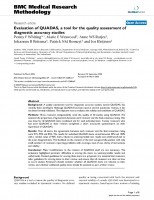Download
| File Size | 219.0 KiB |
|---|---|
| Date | August 31, 2013 |
| Downloads | 0 |
ABSTRACT
Background: A quality assessment tool for diagnostic accuracy studies, named QUADAS, has recently been developed. Although QUADAS has been used in several systematic reviews, it has not been formally validated. The objective was to evaluate the validity and usefulness of QUADAS.
Methods: Three reviewers independently rated the quality of 30 studies using QUADAS. We assessed the proportion of agreements between each reviewer and the final consensus rating. This was done for all QUADAS items combined and for each individual item. Twenty reviewers who had used QUADAS in their reviews completed a short structured questionnaire on their experience of QUADAS.
Results: Over all items, the agreements between each reviewer and the final consensus rating were 91%, 90% and 85%. The results for individual QUADAS items varied between 50% and 100% with a median value of 90%. Items related to uninterpretable test results and withdrawals led to the most disagreements. The feedback on the content of the tool was generally positive with only small numbers of reviewers reporting problems with coverage, ease of use, clarity of instructions and validity.
Conclusion: Major modifications to the content of QUADAS itself are not necessary. The evaluation highlighted particular difficulties in scoring the items on uninterpretable results and withdrawals. Revised guidelines for scoring these items are proposed. It is essential that reviewers tailor guidelines for scoring items to their review, and ensure that all reviewers are clear on how to score studies. Reviewers should consider whether all QUADAS items are relevant to their review, and whether additional quality items should be assessed as part of their review.
Background: A quality assessment tool for diagnostic accuracy studies, named QUADAS, has recently been developed. Although QUADAS has been used in several systematic reviews, it has not been formally validated. The objective was to evaluate the validity and usefulness of QUADAS.
Methods: Three reviewers independently rated the quality of 30 studies using QUADAS. We assessed the proportion of agreements between each reviewer and the final consensus rating. This was done for all QUADAS items combined and for each individual item. Twenty reviewers who had used QUADAS in their reviews completed a short structured questionnaire on their experience of QUADAS.
Results: Over all items, the agreements between each reviewer and the final consensus rating were 91%, 90% and 85%. The results for individual QUADAS items varied between 50% and 100% with a median value of 90%. Items related to uninterpretable test results and withdrawals led to the most disagreements. The feedback on the content of the tool was generally positive with only small numbers of reviewers reporting problems with coverage, ease of use, clarity of instructions and validity.
Conclusion: Major modifications to the content of QUADAS itself are not necessary. The evaluation highlighted particular difficulties in scoring the items on uninterpretable results and withdrawals. Revised guidelines for scoring these items are proposed. It is essential that reviewers tailor guidelines for scoring items to their review, and ensure that all reviewers are clear on how to score studies. Reviewers should consider whether all QUADAS items are relevant to their review, and whether additional quality items should be assessed as part of their review.



